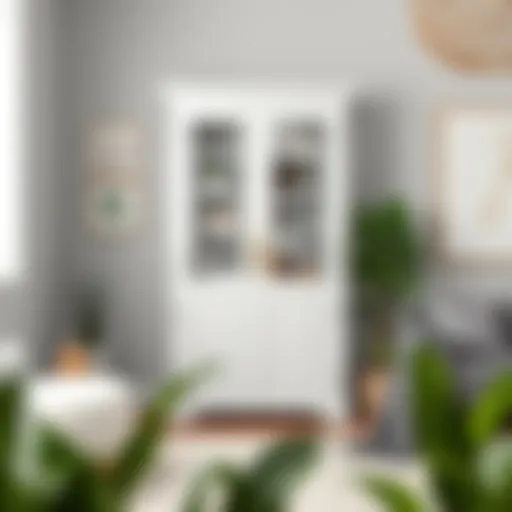Maximizing Space with Bookcases in Closets
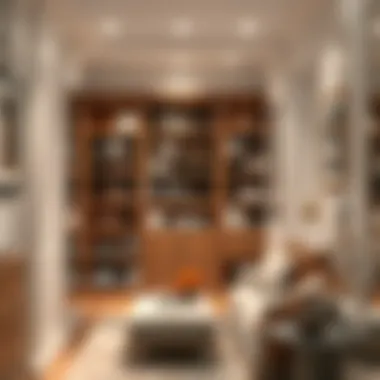
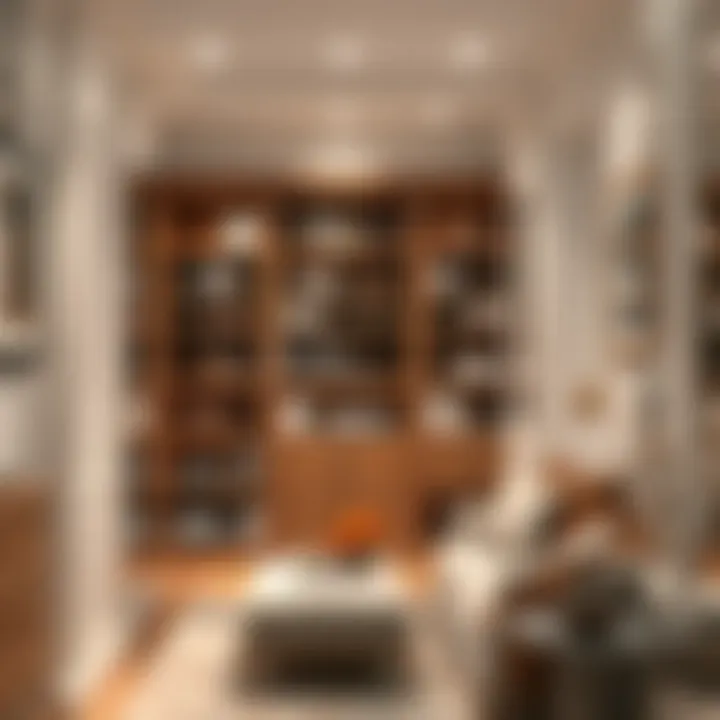
Intro
In today’s fast-paced world, the art of organization has become paramount, particularly within our living spaces. Homeowners and design enthusiasts alike are increasingly seeking innovative ways to maximize their available space. One effective and stylish solution emerges in the form of integrating bookcases within closets. Not only does this approach optimize storage, but it also enhances the aesthetic appeal of what was once an overlooked area. This guide aims to illuminate the intertwining roles of functionality and style as we delve into the integration of bookcases into closet designs.
Furniture Trends and Styles
Current Trends in Furniture Design
The quest for versatile solutions in home organization has led to a multitude of trends in furniture design. These trends emphasize minimalism and functionality while not sacrificing style. A prominent direction is toward multi-purpose furniture. Bookcases, often relegated to living rooms and studies, have found their way into closets, effectively merging storage and display. The rise of open shelving systems is significant, as they offer the flexibility to showcase anything from novels to personal keepsakes.
Popular Furniture Styles and Their Characteristics
Understanding the various furniture styles can help you make informed decisions about incorporating bookcases into your closets. Some popular styles include:
- Contemporary: Known for clean lines and neutral colors, contemporary designs can create a sleek look in your closet, allowing for seamless integration with various decor.
- Rustic: If your home boasts a warm, inviting atmosphere, rustic bookcases made from reclaimed wood can enhance the overall charm, adding character to your closet space.
- Industrial: Featuring metal accents and raw finishes, industrial bookcases can inject an edgy vibe into your closet, perfect for urban dwellers or those seeking a modern twist.
Each style brings its own flair, allowing for creativity in how you display and organize your belongings.
"A well-designed space is not just about aesthetic appeal. It reflects the personalities and lifestyles of those who inhabit it."
Buying and Maintenance Guides
Essential Tips for Purchasing Furniture
When it comes to purchasing bookcases for your closets, consider the following:
- Measure Your Space: Before shopping, ensure you know the dimensions of your closet. This helps narrow down your choices and prevents the headaches of poor fit.
- Evaluate Material: Consider the durability and weight of the material. Solid woods offer sturdiness while laminates provide lighter and often budget-friendly options.
- Style Harmony: Ensure that the bookcase complements the existing decor of your closet and the adjoining rooms. It creates an effortless flow within your home.
Maintenance and Care for Different Furniture Materials
Once you have your bookcase, proper maintenance can extend its lifespan. Here’s how to care for different materials:
- Wood: Regular dusting and the occasional polish can keep your wooden bookcase looking new. Avoid placing it in direct sunlight to prevent fading.
- Metal: For industrial-style bookcases, wipe them down with a damp cloth and dry immediately to prevent rust.
- Laminates: Easy to care for, laminate bookcases can be cleaned with mild soapy water. Just avoid harsh chemicals that can damage the finish.
By thoughtfully selecting and maintaining your bookcases, you can turn your closets into both functional storage and a showcase of your interests and personality.
Foreword to Bookcases in Closets
The integration of bookcases within closets stands as a practical yet artistic solution to optimizing residential spaces. In an age where efficient living is becoming increasingly vital, particularly in urban environments where square footage can be at a premium, merging book storage with closet functionality offers notable advantages. Not only does this approach spotlight the value of multi-functional design, but it also invites a unique aesthetic that can enhance any room’s appeal.
Furthermore, utilizing bookcases in closets can create a harmonious balance between storage and style. This blend offers benefits that extend beyond mere functionality, impacting organization, spatial perception, and even decor aesthetics. Homeowners and designers alike are beginning to see this trend not just as a novel idea, but as an essential consideration when designing spaces. It urges a rethink on how furnishings can coexist while serving individual purposes effectively.
Defining the Concept
In simple terms, integrating bookcases in closets is about placing shelving designed for books or display within the confines of closet spaces. This might sound rudimentary, yet the concept encompasses so much more.
When one thinks of closets, a common image might be of clothes and shoes stacked visibly or hidden away on conventional shelves or racks. Here, we propose broadening that definition. Bookcases can seamlessly replace or complement existing closet fixtures. This not only utilizes often-overlooked space but also adds layers of character and sophistication to a usually utilitarian area.
Imagine a walk-in closet featuring a bookcase that, instead of just storing old clothes, showcases a curated collection of literature, decor items, or even stylish storage boxes. It encourages versatility—giving the room life and style instead of merely functioning as a place to hang garments.
Historical Context of Closet Design
Closets have transformed significantly over the decades. Originally, closets served strictly functional purposes, acting merely as hidden rooms for clothes and accessories. They were often compact spaces lacking any design consideration. In the early 20th century, as fashion and home decor started to evolve, closets began to take on a more spacious and organized role, evolving into walk-in designs with ample space to flaunt belongings proudly.
Historically speaking, the wardrobe as we know it blossomed during the Renaissance. People started to cherish not just the function but the aesthetic of their storage solutions. Fast forward centuries later, the contemporary closet today still leans heavily into functionality, but recent trends show a shift towards visual appeal—wherein integrated features like bookcases come into play.
By reflecting on this evolution, one can appreciate how closets have moved from merely being practical units to becoming integral parts of design schemes within homes. The rise of open floor plans and minimalism has only catalyzed this process, urging homeowners to rethink every square inch of their living spaces, showcasing beauty while embracing functionality.
Benefits of Integrated Design
Integrating bookcases into closets is more than just a trend; it's a practical solution that offers a variety of advantages for homeowners and designers alike. These benefits extend beyond mere storage to encompass aesthetic and organizational improvements. With a growing need for efficient use of space in homes, the thoughtful integration of bookcases into closets emerges as a strategic approach to enhance functionality without sacrificing style.
Space Efficiency
One of the standout benefits of incorporating bookcases into closets is efficient space usage. Closets often serve as underutilized areas, crammed with clothes and forgotten shoes. By installing a bookcase within this confined space, you can transform it into a multi-functional area.
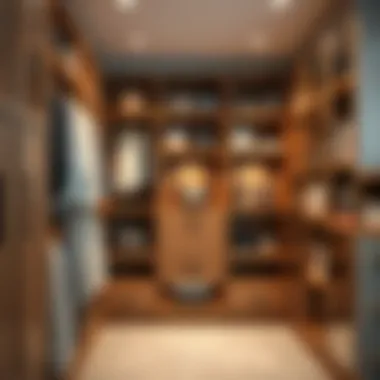
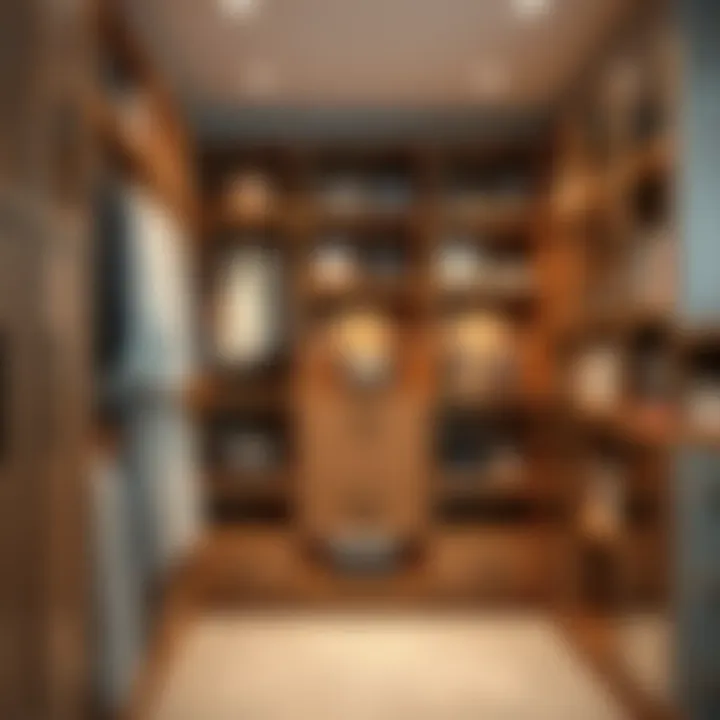
- Vertical Space Utilization: Utilizing bookcases allows both vertical space and horizontal surfaces to serve a new function. When books are stored vertically alongside other items, it maximizes the available square footage. This can turn a cramped closet into an organized oasis.
- Reduced Clutter: By moving books and decor from other rooms into the closet, typically cluttered areas can breathe easier. This not only enhances the organization but can also contribute to a more streamlined, tidy look throughout all areas of the home.
"Closets don’t have to be just for clothing; they can become personalized libraries or displays that reflect your interests."
Aesthetic Cohesion
Another critical advantage is the creation of aesthetic cohesion throughout living spaces. Integrated design fosters a harmonious look that connects different rooms in a home. When bookcases blend seamlessly into closet designs, it enhances visual appeal in several ways:
- Style Harmony: Matching the bookcase design with closet finishes and colors can generate a consistent visual theme throughout a room.
- Enhancing Decor: Books themselves can serve as art pieces, contributing to the overall decor. Richly colored spines or uniquely bound covers can uplift the atmosphere of a closet, making it feel like a curated gallery rather than a storage area.
Enhanced Organization
Incorporating bookcases within closets is not merely for aesthetics; it significantly improves organization, which is a fundamental requirement for any functional space.
- Segmented Storage: Bookcases allow for intentional organization. Books can be categorized by genre or size, while decorative items or everyday essentials can also be organized systematically. This leads to quicker access and a more functional use of the space.
- Personal Touch: An organized closet, with bookcases featuring personal collections, can add character to a home. It becomes a reflection of the individual’s taste, elevating the ordinary closet into a personal statement.
In summary, the benefits of integrating bookcases into closets pursue a triple aim of space efficiency, aesthetic cohesion, and enhanced organization. These features not only meet practical needs but also enrich the visual landscape of homes, making them more inviting and functional.
Design Considerations
When it comes to integrating bookcases within closets, there are several design considerations that can make or break the functionality and aesthetic of the entire system. These elements not only enhance the usability of the space but also ensure that your closet serves its dual purpose effectively: maximizing storage while providing a visually appealing element to the room. Understanding these factors is crucial for homeowners, designers, and DIY enthusiasts looking to optimize their spaces.
Dimensions and Measurements
Getting the dimensions right is paramount. Before diving into the design, one must carefully assess the size of the closet. Measure the width and height, and consider the depth, too. A classic mistake is to overestimate the available space or underestimate the necessary shelf height. For example, if your closet is barely five feet tall but you envision a towering bookcase that reaches for the stars, you'll soon find that reality bites.
Key Points to Consider:
- Ascertain your ceiling height for adequate shelving dimensions.
- Measure the closet width to avoid creating an overly cramped feel.
- Factor in any existing closet rods or other elements you don’t want to remove.
Remember, leaving a bit of breathing room is just as critical as fitting everything you need within the shelves. A cluttered closet can quickly transition from a storage dream to a storage nightmare.
Weight Capacity and Support Structures
When you think about weight capacity, it’s not just about whether the shelves can hold your prized collection of novels or decorative trinkets. It’s about ensuring that the structure is safe and reliable over time. Using the right support structures will prevent disasters that can lead to injury or property damage.
Important Considerations:
- Assess the material used for both the shelves and brackets. Solid wood typically offers more strength than plywood or particle board.
- Install sturdy anchors into the walls for heavy items or books. For instance, if your bookcase is crafted from oak and you plan to load it with hefty volumes, go for brackets rated to bear weights of at least 200 pounds.
- If you’re thinking modular, many systems offer customizable support options which can flex with your storage needs.
Taking these precautions ensures the longevity of your integrated bookcase while sparing you from any precarious situations.
Accessibility and Usability
Your closet should be a haven of order, not a maze of confusion. Accessibility and usability are about ensuring that every part of your integrated bookcase is within reach. You ought to ask yourself: "Will I be able to grab that favorite book without a contortionist training session?"
To optimize usability:
- Consider shelf height: If the shelves are too high, items at the back may become forgotten relics, only to resurface during a spring cleaning. A height of about 12 to 18 inches between shelves often works well for books and keeps things from feeling like a game of twenty questions.
- Incorporate pull-out shelves: These nifty gadgets not only unleash quick access, but they also bring those hard-to-reach items closer to you.
- Use clear labeling: This simple tip can save time and frustration. With clear labels on boxes or even on the shelf edges, you’ll always know where your favorite thriller is hidden or where the winter sweaters are tucked away.
"Accessibility transforms a beautifully designed house into a functioning home. Without it, the best layout is merely artistic abstraction."
By investing time in these considerations, the integration of bookcases within closets can be much more than mere storage solutions; they become an extension of your living space—functional, organized, and stylish.
Material Selection
The choice of material is a cornerstone in the process of integrating bookcases within closets. It’s about more than just what's pleasing to the eye; it's also about functionality, durability, and how these elements marry with your existing decor. For a homeowner, designer, or DIY enthusiast, understanding various materials and their attributes is essential for creating a space that's not only attractive but also practical in daily use.
Wood vs. Metal
In the ongoing debate between wood and metal as primary materials, each comes with unique characteristics that can shape your decision. Wood often brings warmth and a timeless appeal, making it a beloved choice in many homes. Whether it’s oak, maple, or cherry, wood exudes a tactile quality that can soften a space. However, wooden bookcases can be hefty, which often leads to considerations about whether the closet can support their weight.
Conversely, metal offers a sleek, modern look, perfect for contemporary spaces. It can be lighter than wood and often has a higher weight capacity, allowing for strategic storage solutions. However, the coldness of metal might clash with softer textures found in textiles or traditional decor, presenting a challenge in cohesive design.
Ultimately, the decision between wood and metal requires a balance of aesthetics and function. Should you lean toward a cozy, inviting area, or are you looking to establish a clean, slick vibe?
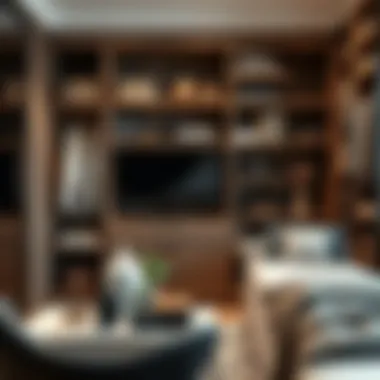
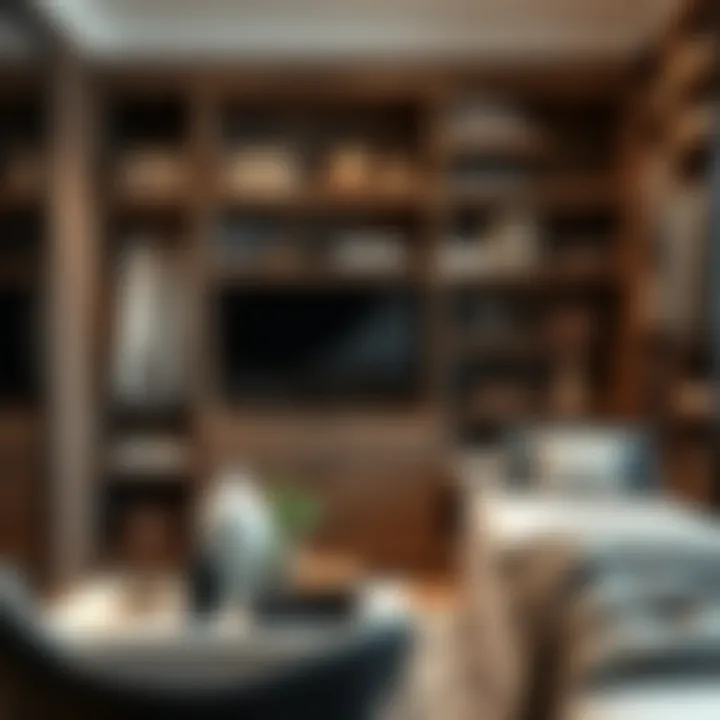
Finishing Techniques
How you finish your chosen material can also greatly influence not just the appearance but also the longevity of your bookcase. For wood, common techniques include staining, painting, or applying a sealant. Staining enhances the natural grain while preserving its authenticity, and painting allows for customizable color options to match any interior scheme. Sealants provide protection against wear and tear, which is crucial for often-used elements such as bookcases.
For metal, finishes such as powder coating can enhance durability while adding a layer of protection against scratches and rust. The finish can also dictate how well the material integrates with other elements in the closet. A matte finish may lend a more understated elegance, while high gloss can bring a modern edge, perfect for those enthusiastic about contemporary designs.
Sustainability Considerations
In today’s eco-conscious world, the sustainability of materials cannot be overlooked. Selecting wood that is sourced from sustainably managed forests is crucial. Certifications like those from the Forest Stewardship Council (FSC) ensure that the timber has been harvested in an environmentally responsible manner. This choice not only reflects an awareness of environmental impacts but also supports efforts to maintain our planet’s resources.
Metal, on the other hand, can often be recycled, contributing to a lower overall environmental impact. Choosing recycled metals can also provide a unique aesthetic that tells a deeper story behind your design choices. However, it is key to examine the entire lifecycle of these materials to truly understand their footprint.
Choosing materials thoughtfully when integrating bookcases into closets ensures a cohesive look that reflects your personal style while serving its functional purpose. With insights on wood versus metal, appropriate finishing techniques, and sustainability choices, you’re well equipped to make a deeply informed decision about your space.
Styles and Themes
When it comes to integrating bookcases into closets, understanding styles and themes is fundamental. Each style not only influences the appearance but also the functionality of the space. It’s like dressing an outfit; you want it to reflect your personality while serving the primary purpose of keeping you organized and efficient. Different themes can create distinct ambiances and practicality, catering to a wide range of tastes and needs. Whether it’s a sleek modern setting or a cozy vintage feel, the style you choose will inform how the space is utilized.
Modern Minimalism
Modern minimalism is all about clean lines, understated elegance, and functional beauty. This style has surged in popularity as homeowners are looking for ways to simplify their lives, and this approach reflects that mindset. When incorporating bookcases in a minimalistic closet, you'll want to focus on neutral colors and smooth surfaces. Think of sleek shelving that blends seamlessly with the walls, maintaining an illusion of spaciousness.
The key here is to utilize the vertical space effectively. Instead of bulky bookcases that crowd the area, opt for slim-profile shelving that can house books, decor, and personal items without overwhelming the senses. Furthermore, leaving some shelves empty can enhance the minimalist aesthetic, allowing for breathing room in what’s often a cramped area.
Classic and Vintage Inspirations
On the other end of the spectrum, classic and vintage inspirations bring warmth and character into closets. This theme draws heavily on elements from the past—think ornate moldings, rich woods, and intricate details. Bookcases that fit into this style often have a certain charm, harking back to times when storage solutions were not just functional but also works of art.
Consider incorporating reclaimed wood or antique furniture find into the closet. Features like ornate knobs or carvings can elevate the visual appeal. Vintage bookcases can often double as a focal point or a statement piece, especially if adorned with classic literature or heirlooms. Moreover, you can create a layered look by mixing books with themed collections or vintage accessories, which offers both style and organization.
Eclectic Combinations
Eclectic combinations represent a melting pot of styles, where contrasts come together to create an inviting space. This approach allows for personal expression, blending modern pieces with vintage finds, and adding quirky elements that reflect individual personalities.
When integrating bookcases within a closet using the eclectic theme, embrace mismatch finishes and colors. This could mean pairing a contemporary metal shelf with traditional wooden cabinets or mixing bold patterns with subtle solid colors. It’s all about creating a curated look that feels collected over time rather than overly designed.
Here are a few tips for pulling off this look successfully:
- Layer Different Textures: Mix wood, metal, and textiles for depth.
- Use Color Wisely: Don’t shy away from bright colors; they offer liveliness.
- Incorporate Accessories: Use unique items or collectibles that tell a story.
Remember: An eclectic space can be as organized as it is visually stimulating; the key is to strike a balance between creativity and functionality.
By understanding these styles and themes, homeowners can better visualize how bookcases fit into their closet spaces effectively. Whether you're drawn to the simplicity of modern minimalism, the nostalgia of classics, or the vibrancy of eclectic combinations, integrating bookcases can enhance both storage and aesthetic appeal. Each choice reflects a unique aspect of personal taste while ensuring that function is not sacrificed for beauty.
Practical Applications
The integration of bookcases within closets is more than just a clever way to stow away your belongings; it’s part of a larger conversation about how we utilize ever-shrinking spaces in our homes. Relying on practical applications helps readers visualize the transformative potential behind every closet door. By bridging the gap between function and aesthetics, the reader can glean insights that elevate their home organization practices to a whole new level.
Custom Built-Ins
Custom built-in bookcases are the crème de la crème when it comes to closet design, allowing homeowners to maximize vertical space efficiently. These bespoke creations don’t just offer storage; they turn an ordinary closet into a personalized haven. With tailored dimensions, they can fill awkward corners, ensuring no square inch goes to waste.
A potential client might seek inspiration from an exceptional case: a family in a cozy three-bedroom bungalow managed to retrofit their master closet with a built-in that seamlessly housed their collection of books and photo albums. The customized drawers below now serve to store miscellaneous items, hiding them from view yet keeping them easily accessible.
Moreover, one unique advantage of built-ins is the option for multipurpose uses. Consider slots designed explicitly for hobby supplies—imagine a small section dedicated to knitting yarn or art supplies—making it your all-in-one creative nook.
Modular Shelving Units
Shifting down a gear, modular shelving units offer an adaptable alternative for those who favor flexibility over permanence. As life circumstances change—be it adding another child to the family, moving to a new home, or cultivating a hobby—modular units can easily be reconfigured or expanded to meet evolving needs.
The beauty of these units lies in their simplicity and versatility. With varying sizes and shapes, they can be designed to sit atop one another or spread horizontally, thus enabling creative usage of closet space. For instance, a family could utilize a tall, narrow modular bookshelf to make a visual impact without overwhelming the remaining closet space. By adjusting the height to suit your personal collection, it's possible to create an eye-catching feature that stays functional.
When designed with an aesthetic approach, these units also open opportunities for decorative touches—they can house decorative boxes, artwork, or small plants, transforming a typically neglected area into one of charm.
Adaptations for Varied Spaces
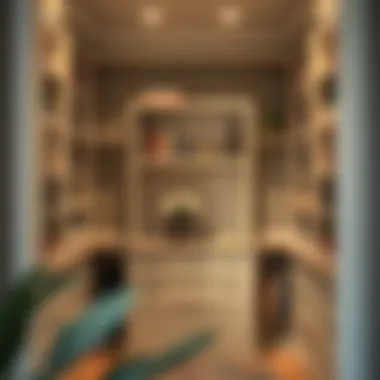
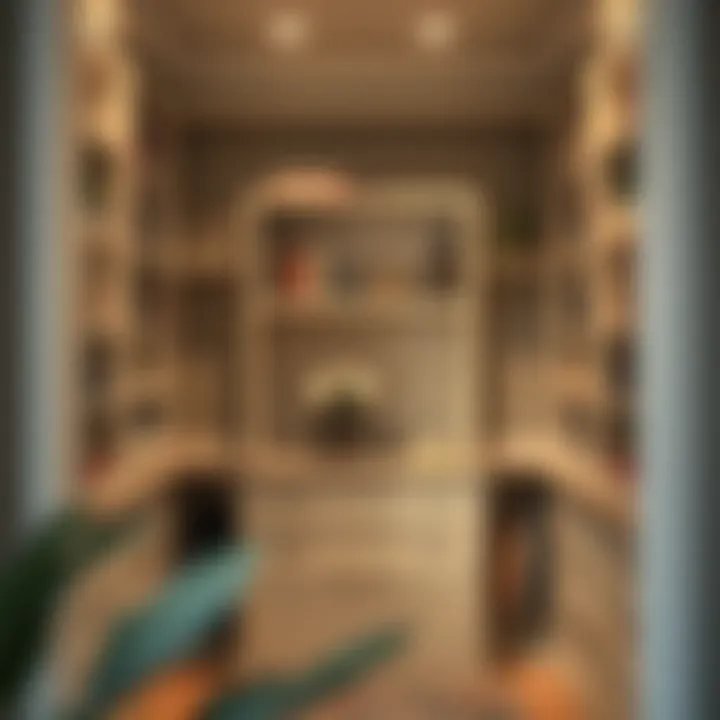
Every home is different, which means not every closet will be compatible with the same bookcase approach. Heights, depths, and the overall layout can vary significantly. The key is to adapt the setup according to the available dimensions. A useful approach is to evaluate the specific characteristics of the closet space in question.
For closets with depth constraints, opting for shallow bookcases can be a game-changer. A narrow depth still allows for books or objects while keeping your closet uncluttered—after all, nobody wants to deal with a rabbit hole of disarray where they can’t even find a matching pair of shoes.
By implementing pull-out baskets or drawers within these adaptations, the homeowner can maintain tidiness without sacrificing access to their stored items. Creating tiered shelves helps utilize vertical space, while corkboard backing can be used for notes and reminders. Other tricks, like mirrored panels, can also visually enlarge the space and add flair.
In essence, by customizing bookcase solutions according to specific closet layouts, homeowners can enjoy functionality and an enhanced view of their possessions.
Ultimately, engaging with the practical aspects of integrating bookcases can lead to an organized, appealing environment that meets both functional and stylistic needs.
Installation Techniques
When it comes to integrating bookcases within closets, the installation techniques play a pivotal role in ensuring that the end result is both functional and visually appealing. The right approach to installation can enhance the stability of the bookcase, optimize the available space, and ultimately contribute to a seamless blend of storage and design. Let’s dive into the essential aspects to consider when installing bookcases in closet spaces.
DIY Installation Guide
Embarking on a DIY installation journey can feel daunting, yet with the right preparation, it can also be incredibly rewarding. Here’s a straightforward guide to help tackle the installation of bookcases within closets:
- Planning Your Layout: Measure the closet space carefully, allowing room for adjustments. Visualizing how the bookcase will fit into this setting is crucial.
- Choosing the Right Materials: Select materials that are not only aesthetically pleasing but also robust enough to hold the weight of books and decorative items. Consider using high-quality plywood or MDF for durability.
- Gathering Tools: Make sure you have all necessary tools on hand, which typically includes a drill, level, wood screws, and a stud finder.
- Starting with the Base: Begin by installing the base of the bookcase, ensuring it is level and securely anchored.
- Assembling the Frame: Construct the framework, ensuring that each component is tightly fitted. Securing the frame to the wall can prevent wobbling.
- Adding Shelves: Measure the spacing based on your storage needs. Adjustable shelves allow for flexibility in organizing various items.
- Finishing Touches: Sand any rough edges and apply a finish or paint as desired to protect the wood and enhance the appearance.
Each of these steps is important; they ensure longevity and functionality, providing a sturdy environment for your belongings.
Hiring Professionals
For those who may feel overwhelmed by the DIY approach or simply prefer to leave it to the experts, hiring professionals can be a wise choice. Here’s what to keep in mind:
- Expertise: Professionals come equipped with significant experience, which can save you time and reduce the likelihood of mistakes during installation.
- Design Guidance: Many installers offer design advice, ensuring that the bookcase not only fits well but also complements the overall aesthetic of your home.
- Efficiency: Skilled installers can often complete the work much quicker than an inexperienced individual, allowing you to enjoy your newly organized space sooner.
- Safety Considerations: Heavy bookshelves need to be securely anchored to prevent tipping. An expert can ensure that safety measures are adhered to, providing peace of mind.
Choosing between DIY and professional installation boils down to personal preference and individual comfort levels with such projects. Weigh the pros and cons based on your skill set and the complexity of your specific closet bookcase design.
"A well-installed bookcase not only serves its purpose but also enhances the overall decor, adding character to the closet space."
Epilogue
Ultimately, whether you’re embracing the DIY spirit or opting for professional assistance, effective installation techniques are foundational in maximizing the potential of bookcases within closets. With proper execution, you can transform a mundane area into a practical and stylish storage solution.
Maintaining the Integration
When one considers the blend of functionality and style in interior design, the inclusion of bookcases in closets serves as an ingenious method of maximizing space effectively. Yet, a crucial step often overlooked by homeowners is the importance of maintaining this integration. Proper maintenance ensures that the aesthetic integrity and practical utility of the bookcase system remain intact over time. It encompasses two critical aspects: Cleaning and Care and Regular Assessment and Adjustments. Both elements are essential to preserve the longevity and functionality of this unique design feature.
Cleaning and Care
Keeping your integrated bookcases clean isn't just for appearances—it's about sustaining their structural integrity too. Dust and dirt can accumulate and, if left unattended, might lead to more significant issues. Here are some practical tips to maintain your bookcases:
- Use a soft, damp cloth for cleaning wooden surfaces. Avoid harsh cleaners that can strip the finish or warp the material.
- Incorporate a regular dusting schedule. Aim for at least once a month to wipe down shelves and the spines of books. This practice not only keeps things tidy but also helps to identify signs of wear and tear early on.
- For fabric-bound books, such as those displayed on your shelves, consider using a vacuum with a brush attachment to gently clean their surfaces, avoiding potential dust build-up.
Regular care might sound tedious, but it can save you from potential headaches down the road. A little maintenance keeps your integrated design looking sharp.
Regular Assessment and Adjustments
Adjustments are just as vital as cleaning. As seasons change or routines evolve, the needs for your closet space may shift, prompting a reevaluation of how you store items. Here are suggestions for conducting regular assessments:
- Schedule Seasonal Reviews: Take a moment each season to check the organization of your bookcases. Are items becoming crowded? Is there a section that seems to be collecting dust? Seasonal evaluations facilitate a proactive approach to decluttering.
- Reorganize Based on Usage: Items you use most often should be easily accessible. Don’t hesitate to reposition books or decorative elements when you feel they're not serving their purpose well anymore.
- Weight Capacity Check: Ensure the shelves are adequately supporting the weight of the books and decor placed upon them. Over time, humidity can affect wood, so practicing a routine check to ascertain if the shelves sag or warp is beneficial.
- Style Updates: The aesthetic of your home may change over time, which makes it essential to align the bookcases with the current theme or decor of the closet or surrounding space. This sometimes means adding or removing items to fit new color palettes or styles.
"Regular maintenance doesn’t just preserve the integrity of your bookcases; it enhances their visual appeal and usability as well."
Ending and Future Trends
Integrating bookcases into closet spaces represents more than just a trend; it's a reflection of evolving design philosophies that prioritize function and form. As lifestyles shift towards smaller living spaces, the significance of intelligent storage solutions grows. This article underscores the vital role that bookcases play in maximizing space while keeping the aesthetic appeal intact.
The dual benefit of increased storage and visual harmony cannot be overstated. Homeowners are encouraged to view closets not merely as utilitarian spaces but as extensions of their personal style. Customizing bookcase integration not only optimizes available square footage but also provides an opportunity for creative expression. Think about it: A well-placed bookcase can transform a drab closet into a curated library, showcasing one's literary tastes and interests.
Summary of Key Points
To encapsulate the primary elements discussed:
- Space Efficiency: Using bookcases within closets taps into often-neglected vertical space, making the most of every inch available.
- Aesthetics: Proper integration of bookcases enhances the overall visual appeal of the home, ensuring that functionality does not come at the expense of style.
- Organization: With a dedicated place for books and other items, maintaining order becomes much easier, promoting a clutter-free environment.
- Material Choices: Choosing the right materials is crucial; durable wood may offer a classic look, while metal shelves can create a modern edge.
- Design Trends: Adapting bookcases in closets allows homeowners to embrace various styles, whether it’s minimalism, vintage charm, or eclectic mixes.
Anticipating Design Innovations
Looking ahead, the integration of bookcases into closet spaces hints at promising developments in home design. As technology continues to advance, smart-home solutions are expected to enhance storage capabilities. Imagine shelving systems that can automatically adjust their dimensions or lighting systems that highlight specific sections of a closet.
Moreover, the sustainability movement is leading designers to source eco-friendly materials for bookcases, ensuring that even aesthetic choices align with environmental values. It’s likely that we’ll see an increase in customizable systems where homeowners can easily modify their bookcases to suit changing needs over time.







